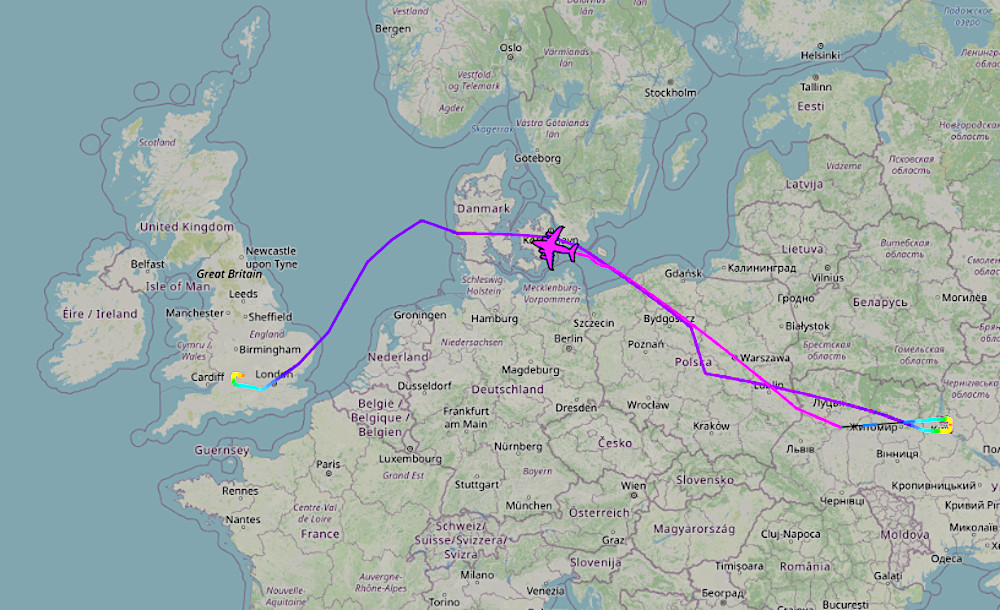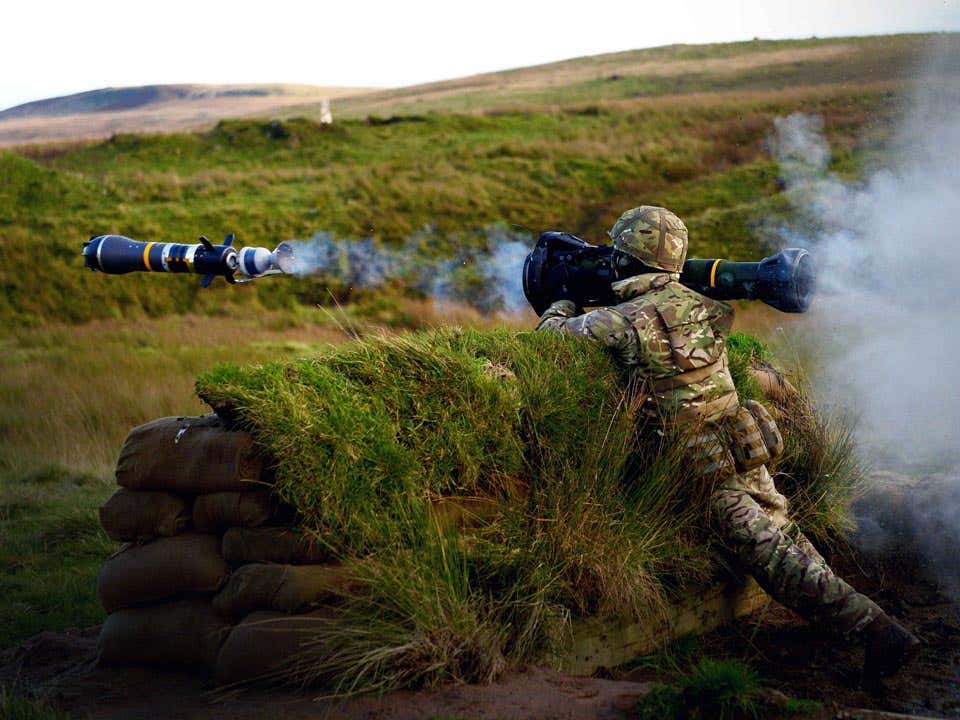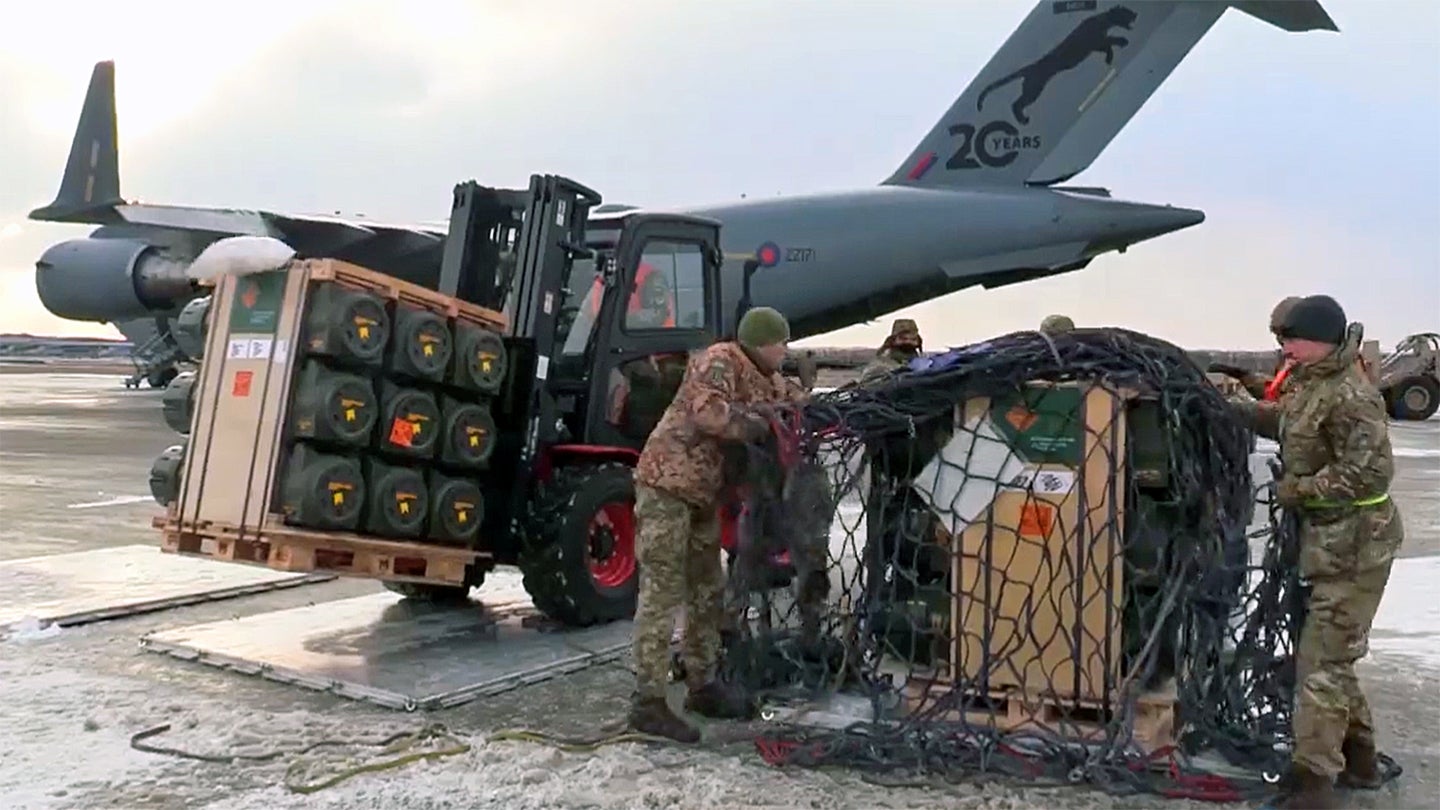Officials in the United Kingdom and Germany have pushed back against speculation that there has been some kind of diplomatic disagreement between the two countries over a British airbridge operation that is delivering Next Generation Light Anti-tank Weapons, or NLAWs, to Ukraine.
U.K. Royal Air Force C-17 cargo planes began flying sorties to Boryspil International Airport outside the Ukrainian capital Kyiv yesterday, taking a route that appeared designed to avoid German airspace, after British authorities publicly announced the planned arms shipments. This all comes amid simmering concerns that Russia may be planning to launch a new, large-scale military intervention into Ukraine, fears that have sparked anew as Russian troops flood into neighboring Belarus ostensibly for snap exercises next month.
German authorities have made clear that they did not ban the British flights from entering their airspace for any reason and U.K. officials had not requested permission to send the C-17s over their country on the way to Ukraine in the first place. This was subsequently confirmed by the U.K. Ministry of Defense.
The exact reason or reasons why all of the RAF C-17 flights to Ukraine that have been tracked online so far, two more of which occurred today, have taken the route that skirts Germany remains unclear. The flight path takes the jets out over the North Sea, before sending them east across Denmark and into the Baltic Sea. From there, they turn southeast and fly through Poland to Ukraine. The aircraft fly back to the United Kingdom on the same route, just in reverse.

On Twitter, Andy Netherwood, a former RAF C-17 pilot, suggested favorable winds or other weather, as well as a possible desire to avoid having to go through entirely normal procedures to secure approval to fly planeloads of munitions across Germany, might be factors. There also remains the possibility that British and German authorities came to an understanding of some kind before the flights even began about not using the latter country’s airspace for these flights over diplomatic sensitivities.
The current German government has a complex relationship with Russia, most notably over an increasingly controversial gas pipeline project, called Nord Stream 2, which is now delayed ostensibly over administrative issues. German officials have faced growing pressure to at least threaten to scrap the project entirely if the Kremlin launches a new invasion of Ukraine.
Regardless, the RAF airbridge to Ukraine appears to be continuing steadily into its second day.
“We have taken the decision to supply Ukraine with light, anti-armor, defensive weapon systems,” U.K. Defense Secretary Ben Wallace told members of the country’s parliament yesterday. “A small number of U.K. personnel will also provide early-stage training for a short period of time, within the framework of Operation Orbital before then returning to the United Kingdom.”
Operational Orbital is the official name of the British military’s security assistance mission in Ukraine, which began in 2015 in the aftermath of Russia’s seizure of the Crimea region and the Kremlin’s subsequent active support for ostensibly local ‘separatists’ fighting against the government in Kyiv.
“Let me be clear: this support is for short-range, and clearly defensive weapons capabilities; they are not strategic weapons and pose no threat to Russia,” Wallace continued. “They are to use in self-defense and the UK personnel providing the early-stage training will return to the United Kingdom after completing it.”
As for what the C-17s are carrying, British authorities did not specified what “anti-armor” weapons they are supplying to the Ukrainian military. It has since been confirmed by Ukrainian officials that aircraft are carrying loads of Next Generation Light Anti-tank Weapons (NLAW) taken from British stocks.

The NLAW, also known as the Main Battle Tank and Light Anti-tank Weapon (MBT LAW), is a single-shot infantry anti-tank system consisting of a disposable launcher preloaded with a single guided missile. The weapon can be fired in two distinct modes, direct attack and top attack, in which the NLAW’s munition is set to detonate above a tank where the armor is typically weakest.

We don’t have a sense yet of how many NLAWs Ukraine might ultimately receive. Video footage of the weapons arriving in Ukraine, seen below, suggests that hundreds of these missiles may have arrived so far.
Regardless, guided anti-tank weapons have long been viewed as an important equalizer for the Ukrainian military in any future large-scale conflict with the Russians, who have a general superiority in quantity and, in some ways, quality, including when it comes to tanks and other heavy armored vehicles. They have also been presented as a deterrent against future Russian aggression for many of the same general reasons. In his remarks to parliament, U.K. Defense Secretary Wallace specifically mentioned tanks and armored fighting vehicles, as well as rocket artillery systems and short-range ballistic missiles, as among the threats that Russia has arrayed along Ukraine’s borders in recent months. The Kremlin has deployed tens of thousands of troops to these same areas along with this materiel.
With this in mind, it’s not surprising that U.S.-made Javelin anti-tank missiles, highly capable weapons that are fired from a reloadable launch system, unlike NLAW, are often touted as one of the country’s more significant defense acquisitions in recent years. Last December, the Ukrainian military showed off the results of a live-fire demonstration of Javelins against targets meant to represent Russian tanks fitted with improvised cage armor on top. Russian tanks in this configuration have been spotted in areas along Ukraine’s borders in recent months.
The U.S. government has sent additional Javelins to Ukraine, among other weapons and equipment, and has been looking to put together additional military assistance packages. A number of America’s allies and partners beyond the United Kingdom have been doing the same, with Estonia notably taking Javelins out of its own stocks to pass along to the Ukrainian military. The Estonians have been looking to send second-hand Soviet-era howitzers and ammunition for them to Ukraine, as well.
In addition, infantry anti-tank weapons, especially ones that Ukrainian troops already have experience with like Javelin, represent a valuable boost in capability that can be fielded rapidly. Steeper training requirements are likely among the factors why the government of Ukraine has received much less of a response from its international partners to its appeals to help it bolster its air and missile defense capabilities.
The RAF’s new airbridge to Ukraine only helps to underscore how time is increasingly not on Ukraine’s side. We’re now at a stage where Russia could at any point launch an attack on Ukraine,” White House Press Secretary Jen Psaki said today.
In recent weeks, more Russian military personnel and hardware have been pouring into Belarus ostensibly for upcoming exercises to be held in conjunction with the former Soviet state. The joint Russian/Belarusian drills are set to take place along Belarus’ southern and western borders, close to both Ukraine and Poland. The exercises will officially start in February and will consist of two phases, the first of which will, at least officially, focus on the basic act of mobilizing large numbers of units in order to defend critical facilities and Belarusian airspace.
The second phase of the exercises, which is scheduled to run from February 10 to 20, is officially aimed at preparing forces for “suppressing and repelling external aggression in the course of a defensive operation, countering terrorism, and protecting the interests of the Union State,” according to Russian deputy defense minister Alexander Fomin.
What has already caused concern is the obvious fact that the deployment of more Russian forces to southern Belarus can only put them in a potential position to swing into northern Ukraine. This, in turn, has raised questions about whether or these are deployments are actually exercises.
“This is neither an exercise nor normal troop movement,” a senior U.S. State Department official said during a call with reporters today. “It is a show of strength designed to cause or give false pretext for a crisis as Russia plans for a possible invasion. And let’s be clear: It’s extremely dangerous.”
“What concerns us is the total picture, right? And I would point to the briefing that was provided this morning, right? It is the amassing of 100,000 troops along Ukraine’s borders combined with moving forces into Belarus over the weekend,” another senior State Department official said during a separate call later in the day. “These numbers are beyond, of course, what we would expect with regard to a normal exercise, right? A normal exercise requires notification 42 days in advance if you’re talking about 9,000 troops, right? Normal – and 13,000 requires international observers. That’s what normal looks like. What this is is something entirely different.”
Experts have further pointed out that it would also put them in a place where they might frustrate efforts by the United States, and other countries, to support Ukraine now, including through the use of manned and unmanned aircraft to gather intelligence, as well as during any future Russian incursion.
There are other worrisome signs that the Kremlin may be moving closer to making a final decision to use military force against Ukraine to secure its policy objectives. For one, Russia has begun shrinking its diplomatic presence in Kyiv, sending diplomats and their families home from Russian consulates on Ukrainian soil. Russian government officials and members of the country’s parliament, the Duma, are using increasingly fiery rhetoric and spewing more disinformation about the situation, tactics that Russian routinely uses to obscure its own activities. Belarus’ dictatorial president Alexander Lukashenko, a major ally of Russian President Vladimir Putin who is embroiled in his own spat with countries along his western borders, has taken an equally hard line on the situation in Ukraine.
Altogether, these developments are clearly driving the latest spike in concerns about a potential new Russian invasion of Ukraine, which could come very soon should the Kremlin decide to take that course of action. This is clearly, among other things, driving the British government’s efforts to move as many NLAW missiles into Ukraine as it can and do so in short order to potentially have a deterrent effect via its new airbridge.
Contact the author: joe@thedrive.com
